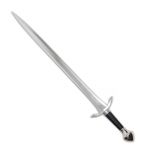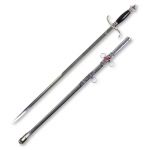Medieval Swords - Longswords & Knight Swords
-
$189.95
-
$109.95
-
$149.95
-
$149.95
-
$79.95
Take the longsword, for example. This wasn't some decorative showpiece. It was a primary weapon on the battlefield from the 13th to the early 16th century. With a straight, double-edged blade and a long grip designed for two hands, the medieval longsword offered serious reach and power. It's the kind of sword you'd see in the hands of a trained fighter practicing the German school of swordsmanship, using techniques passed down from masters like Johannes Liechtenauer.
Looking for something earlier? The arming sword, often just called a knight sword, was the go-to sidearm during the 11th and 12th centuries. Lighter and more compact than a longsword, it paired perfectly with a shield or buckler. This was the classic knight's sword, used during the Crusades and often worn with a full suit of chainmail. Many of our knight swords reflect these historic dimensions, with blade lengths around 28 to 32 inches and a balance point just forward of the hilt for control in tight engagements.
We also carry middle ages swords modeled after real historical examples from across Europe. Blades from the 14th and 15th centuries often taper to a sharp point, optimized for thrusting into the gaps of plate armor. These are very different from the wide, flat blades used earlier in the middle ages, which were designed more for slashing through leather or mail. The evolution of the middle ages sword wasn't random. It was a direct response to changes in armor, tactics, and battlefield conditions.
You'll find a range of knight swords in our collection that reflect this timeline. Some feature wide fullers to reduce weight, others use Type XV blade profiles for piercing power. We pay close attention to proportions, steel type, and historical details. If you're after a knight's sword that could realistically have been carried at Agincourt or during the Hundred Years' War, we've got options that hit the mark.
Of course, not every sword was designed for combat. Some were made for ceremony or as status symbols. These pieces often feature elaborate guards, engraved pommels, and ornate scabbards. You might not take a blade like that into battle, but it would absolutely hang at a noble's side during a court appearance. Our selection includes both functional swords and display swords, so whether you're swinging or showcasing, you'll find something here that fits.
And while we stay true to historical accuracy where it matters, we're not stuck in the past. Some of our combat-ready medieval swords are made with modern high-carbon steel and full tang construction. That means they're not just for looks. These are fully functional weapons that can hold up to real training and test cutting. For anyone practicing historical European martial arts (HEMA), a well-balanced, properly tempered sword is a must. Many of our knight swords meet those specs.
Collectors often ask about knights swords from specific regions. French swords tended to be slender and quick, great for thrusting. English blades often had broader designs, prioritizing chopping power. German smiths, especially from the Passau and Solingen regions, were known for their craftsmanship. Our inventory reflects this variety, with middle ages swords that draw from English, French, Italian, and German traditions.
We also offer replicas inspired by legendary weapons, like Oakeshott Type XII swords used during the early Crusades, or Type XVIII blades favored in the late 15th century. These classifications aren't just collector jargon. They refer to real differences in blade geometry, grip shape, and overall purpose. When you pick up a medieval sword that's been properly designed, the feel is completely different from a generic fantasy blade.
So if you're looking for knight swords with real historical roots, or combat-ready medieval swords that are more than wall hangers, you're in the right place. Browse our selection and find a blade that actually feels like it belongs in the hand of a 14th-century knight.
What's the difference between a longsword and a knight sword?
The terms longsword and knight sword refer to two distinct types of European swords used during the medieval period, and the differences come down to size, handling, time period, and combat style.
A longsword is a two-handed sword that was primarily used from the late 13th century through the 16th century. It features a straight, double-edged blade, typically around 36 to 45 inches in length. The grip is long enough to accommodate both hands, which gives the user more leverage for powerful strikes, controlled thrusts, and complex blade work. Longswords were commonly used in armored combat and are heavily featured in historical martial arts manuals from masters like Johannes Liechtenauer and Fiore dei Liberi. The fighting style includes techniques like half-swording, grappling, thrusts, and cuts from the bind, which were effective against both plate and mail armor.
A knight sword, often called an arming sword, is a one-handed sword that was standard during the High Middle Ages, especially the 11th through 13th centuries. These swords usually have blades ranging from 28 to 32 inches and were designed to be used alongside a shield. The knight sword is characterized by its straight blade, cruciform guard, and simple pommel. Unlike the longsword, the knight sword is lighter and shorter, making it better suited for use on horseback or in combination with a kite or heater shield. It was common during the Crusades and often carried as a sidearm by knights even after longer swords became popular.
The main technical difference is in how each sword is wielded. The longsword is optimized for two-handed use, offering superior control, reach, and power. The knight sword is strictly a one-handed weapon and relies more on pairing with a shield for defense. Because of this, longswords are better suited for standalone use in unarmored or lightly armored combat, while knight swords were part of a broader fighting system involving shields and formation tactics.
Historically, the knight sword came first. It dominated the battlefield during the 11th and 12th centuries when mail armor was common and mobility mattered. As plate armor evolved and knights required more powerful and adaptable weapons, the longsword became the standard for both battlefield and judicial duels.
To summarize:
Knight Sword (Arming Sword):
- One-handed
- Shorter blade (28-32 inches)
- Used with a shield
- Common from 11th to 13th centuries
- Suited for mounted combat and formations
Longsword:
- Two-handed
- Longer blade (36-45 inches)
- Used without a shield
- Common from 14th to 16th centuries
- Suited for armored duels and individual combat
Both are authentic examples of middle ages swords, but they reflect different points in the evolution of European swordsmanship and battlefield tactics. Choosing between them depends on the historical period you're interested in and the type of combat or collection you're focused on.








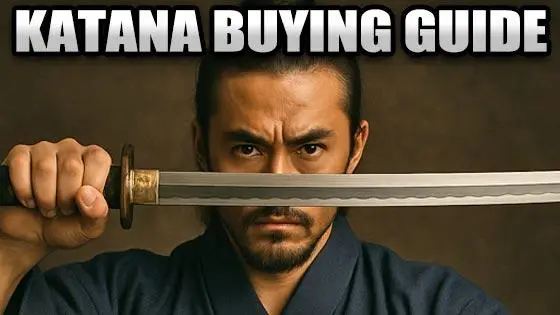


 (1)
(1)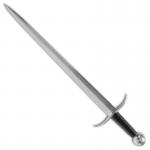

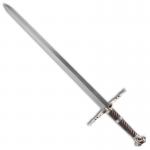

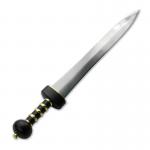
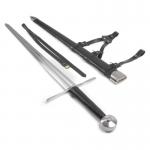
 (2)
(2)